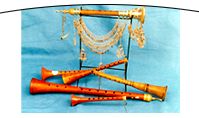Zurna
Zurna
One of the most important instruments in traditional/local music. The pipe
was first made from tree bark, and later panels of copper or brass were added.
In the past, the instrument was known by the names ‘curna,’ ‘zurr,’ ‘sarna’ and
‘sorna,’ and called the ‘sernay’ in Persian. The pipe widens towards the bottom,
and a reed is placed at the mouth in order to play it. There are a total of
seven holes, six on the top and one on the side. The left hand plays the holes
nearest the mouth, and the right the remainder.
 This
pipe can send sounds a long way, which makes it rather distinctive among the
musical instruments of the world. It has a powerful, colourful, lively and
grandiose sound. The considerable noise it makes means it is largely played in
open areas, village weddings, military ceremonies, sports activities, folk
dances and the like. It is known to have been used to accompany a number of
traditional dances.
This
pipe can send sounds a long way, which makes it rather distinctive among the
musical instruments of the world. It has a powerful, colourful, lively and
grandiose sound. The considerable noise it makes means it is largely played in
open areas, village weddings, military ceremonies, sports activities, folk
dances and the like. It is known to have been used to accompany a number of
traditional dances.
The zurna also occupied an important place in Ottoman mehter music, and is
known by the names ‘cornet turc,’ ‘corne turc,’ and ‘cornet des turcs,’ and in
Hungary by the name ‘török sip.’
The instrument varies between 60 and 30 cm. long, and comes in three types
according to it s sound: kaba zurna, orta kaba zurna and cura zurna (zil zurna).
It tends to be made from woods such as plum, apricot and boxwood.
Sound of the zurna/mp3 (583 KB)
Sound of the zurna/rm (109 KB)
Picture: Zurna